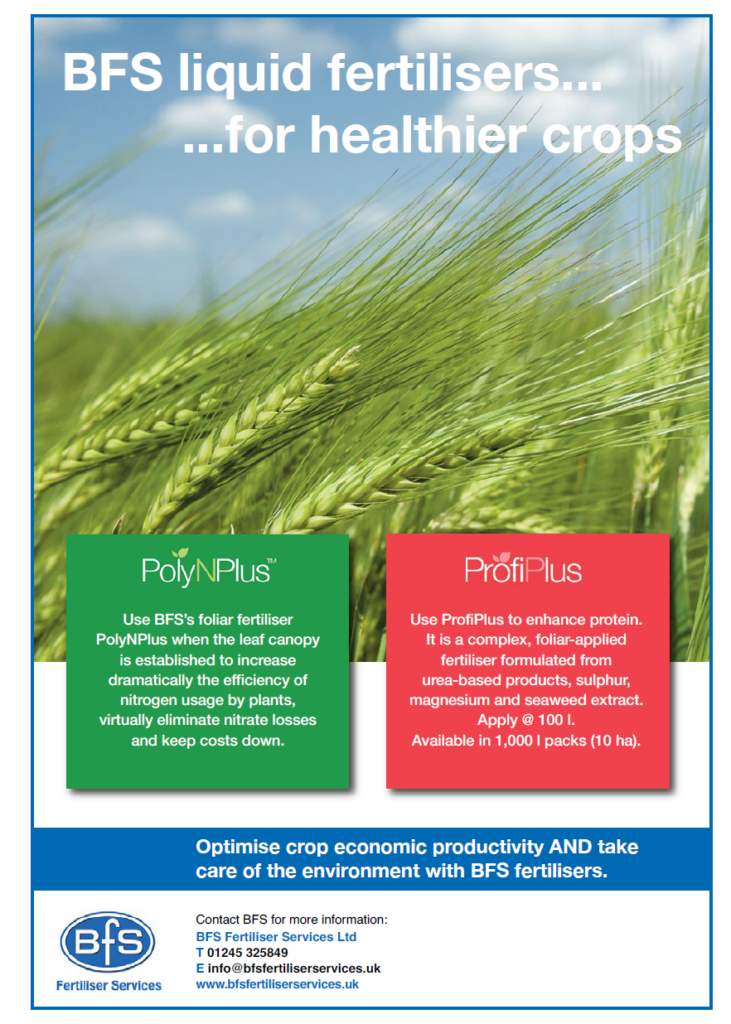Rosalind Platt is managing director of crop nutrition specialists BFS Fertiliser Services Limited.
Foliar nitrogen treatments later in the season reduce the total amount of nitrogen needed while maintaining or lifting yield, and increasing protein.
The pressure on farmers today seems more relentless than ever. Key priorities are to maximise soil health and nitrogen use efficiency while maintaining yields, as well as increasing protein levels in milling wheat. As a UK leader in crop nutrition for more than 75 years, BFS has developed fertiliser programmes tailored to meet these challenges.
One solution is our foliar nitrogen product, PolyNPlus Foliars; another – our protein enhancers, Profol and ProfiPlus – gives farmers flexible options to increase protein in milling wheat.
Over many years, independent research on PolyNPlus by one of Britain’s oldest agricultural research centres, NIAB, and international farm managers and agronomists, Velcourt, has verified the excellent results achieved by farmers.
Nitrogen, vital to maximise yields in crop production, is traditionally soil-applied as ammonium nitrate, urea or liquid UAN. Farmers would normally make two or three applications of soil-applied fertiliser in the spring. But later in the season the nitrogen use efficiency of these types of fertiliser, whether solid or liquid, can decline to 25 to 30%, especially when the conditions are dry – see charts.


When the leaf canopy is sufficient, PolyNPlus Foliars can replace a proportion of the soil-applied nitrogen for a wide range of crops including cereals, oilseed rape, sugar beet, potatoes and maize. Application timings combine well with fungicide.
Application rates vary by crop. As a guide, and depending on soil and weather factors, 25 litres of PolyNPlus – supplying just 8kg of nitrogen – can replace 40 to 50kg of any type of soil-applied nitrogen. This can cut the carbon footprint of the third application by 77 per cent – PolyNPlus’s sticky nature prevents nitrate loss, avoiding groundwater contamination, and the loss of ammonia is minimal.
Therefore farmers can apply less nitrogen while maintaining or increasing yields.
Paul Jannaway, a Wiltshire-based contractor working with several large landowners, said: ‘The yields and quality of the products we harvested were excellent. I applied PolyNPlus in all conditions, even when it was very hot, and had absolutely no scorch. I believe we will see a lot more of this product – PolyNPlus is the future.’ As well as using PolyNPlus successfully on wheat and rape, he has used it on oats just before the panicles or oat heads emerged, and recorded a bumper crop.
PolyNPlus is the only foliar nitrogen which has been extensively and independently trialled.
Protein enhancement
To increase protein later in the season for milling wheat showing potential, applying additional nitrogen at growth stages 69 to 75 is highly effective. BFS’s urea-based solutions boost protein and improve the prospect of premium prices.
BFS Profol (18N) is a urea solution and, as a foliar application, has a rapid uptake even in dry weather. It is used at 200 litres per hectare to provide 40kgs of nitrogen per hectare.
If a smaller quantity or reduced application rates are preferred, we supply ProfiPlus, for which the timing of application is more flexible, in 10 hectare packs. It is a hybrid product which includes a small amount of PolyNPlus, sulphur, magnesium and seaweed extract. These ensure rapid uptake and slower release of nitrogen, meaning ProfiPlus can be applied earlier than Profol, and making it more efficient than other solutions.
A foliar future
Foliar nitrogen is set to play an essential role in the future of farming. It is a cost-effective way of improving nitrogen use efficiency, maintaining or increasing yield and protein, reducing pollution and cutting a farm’s carbon footprint.


